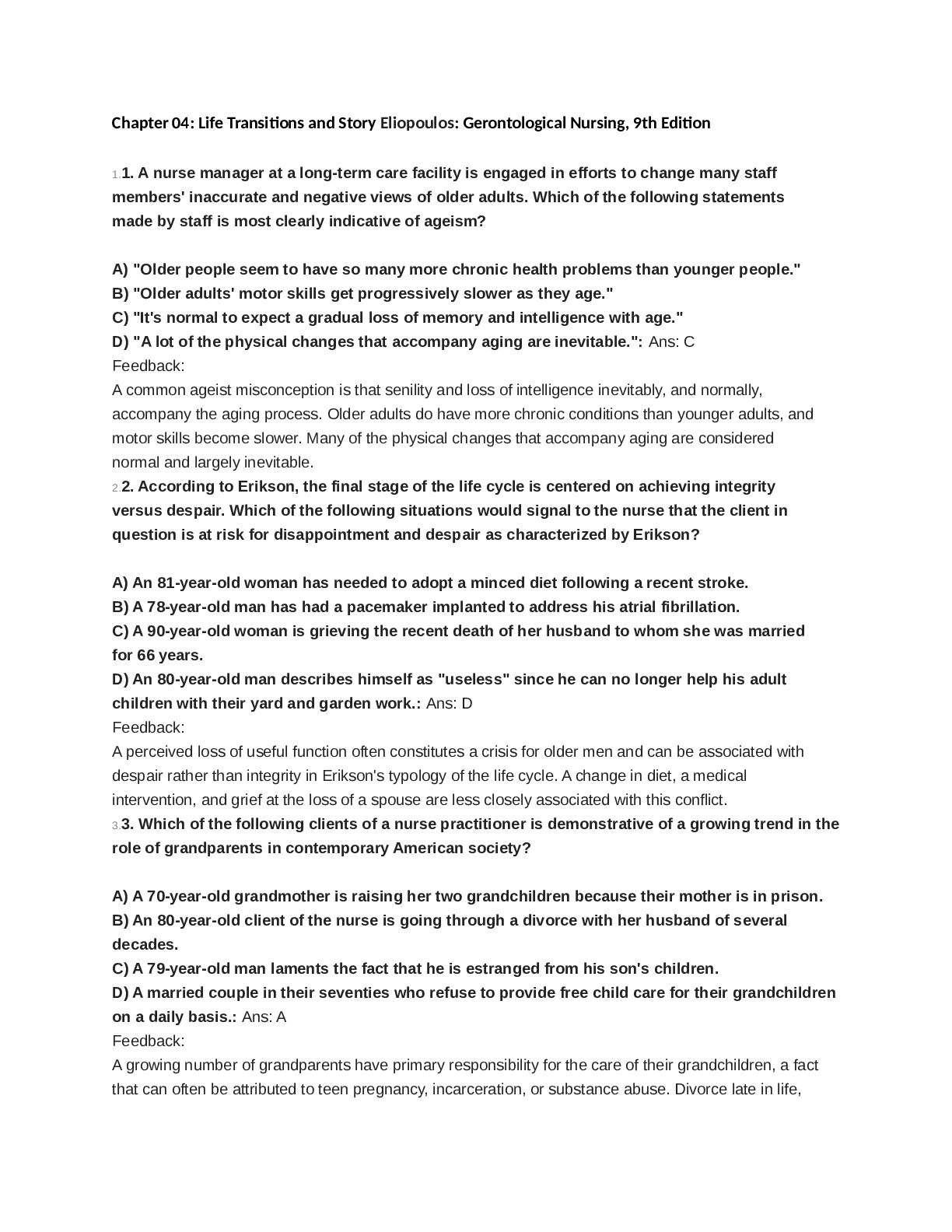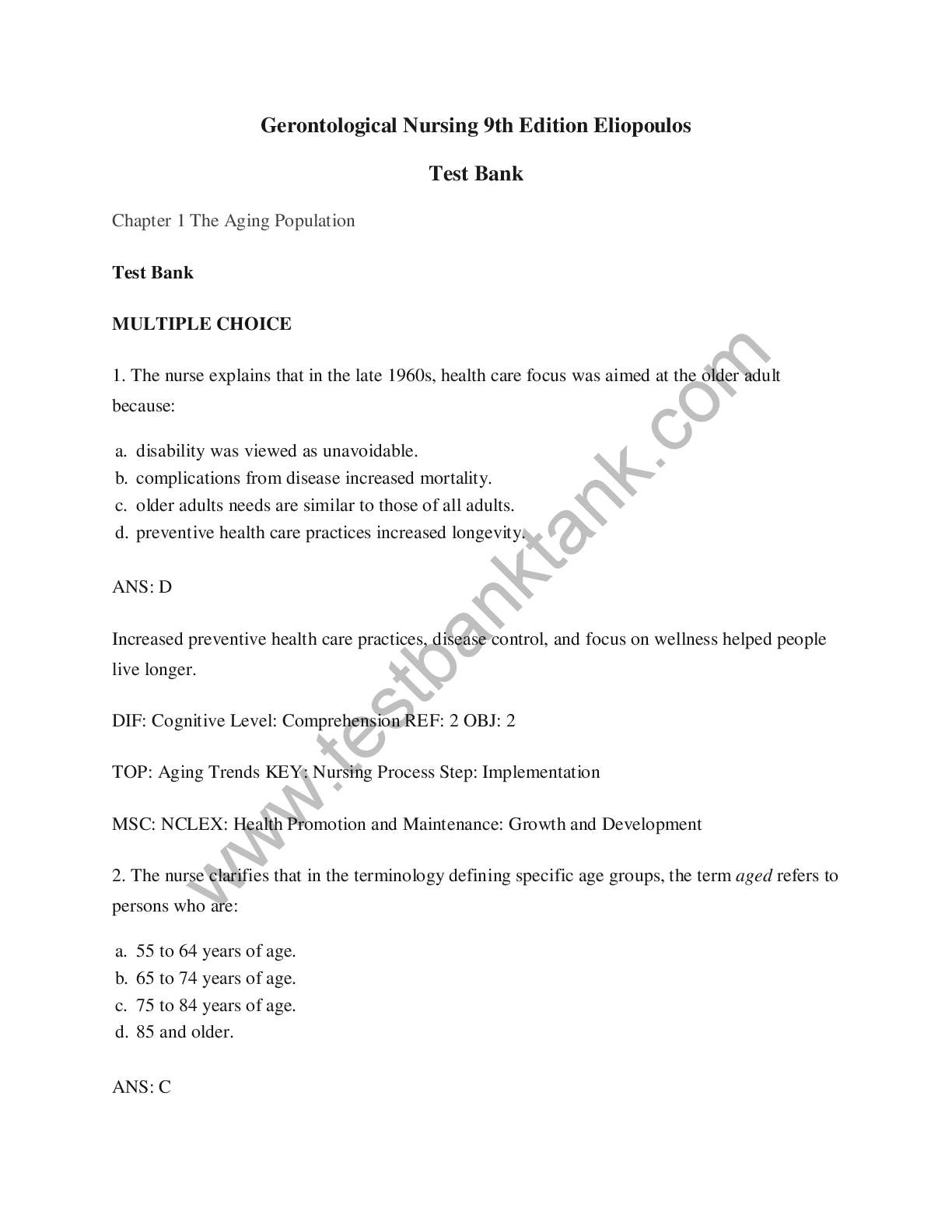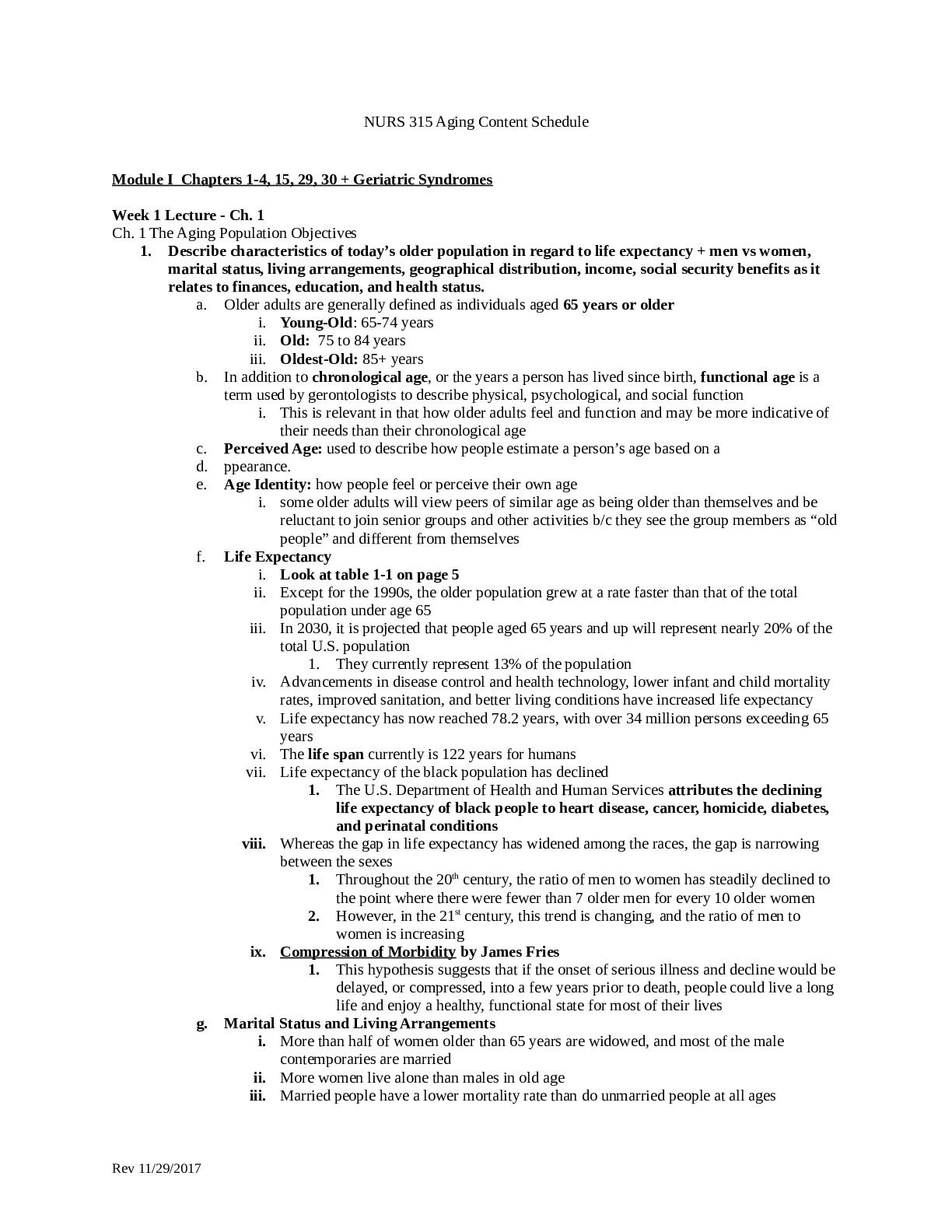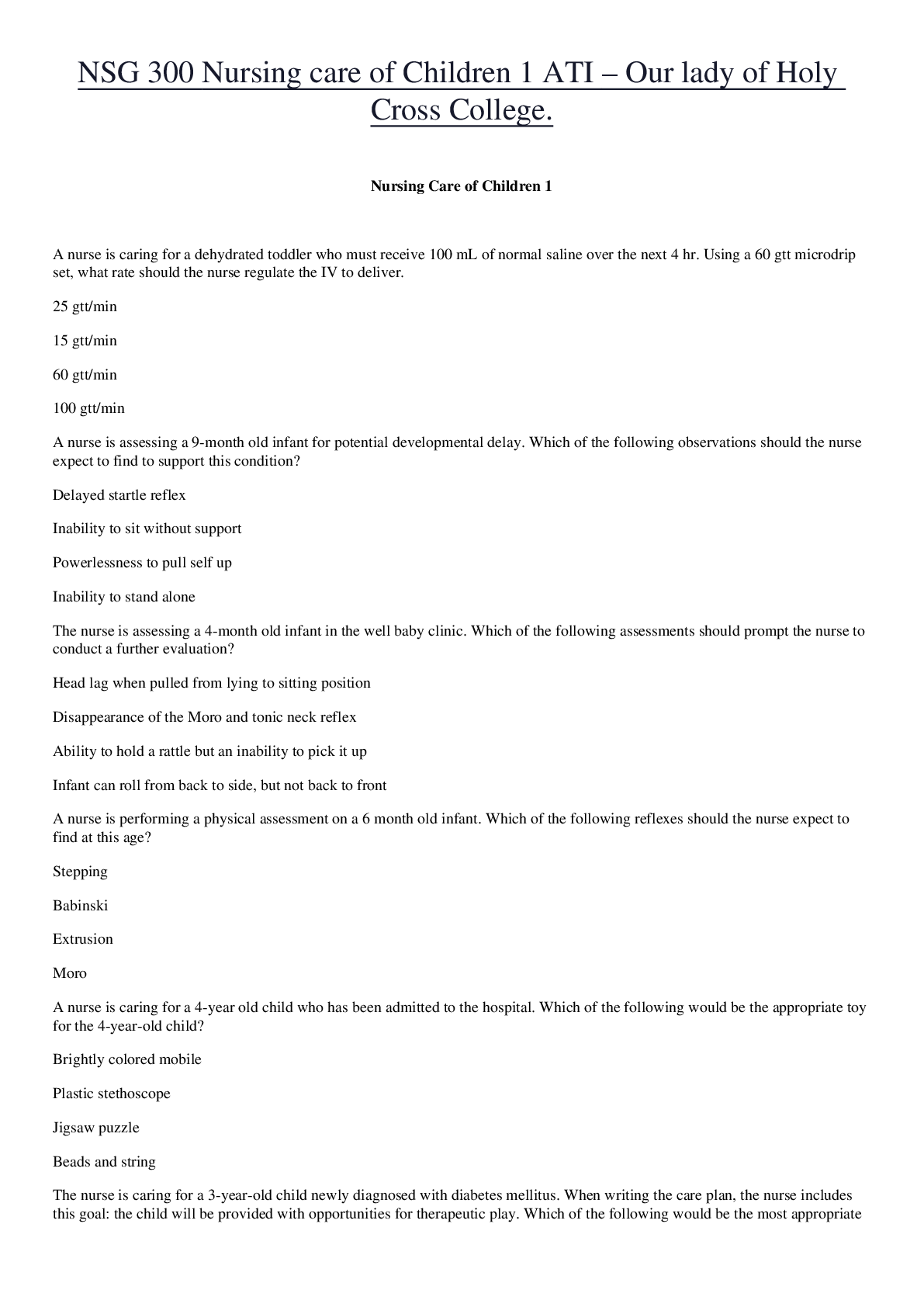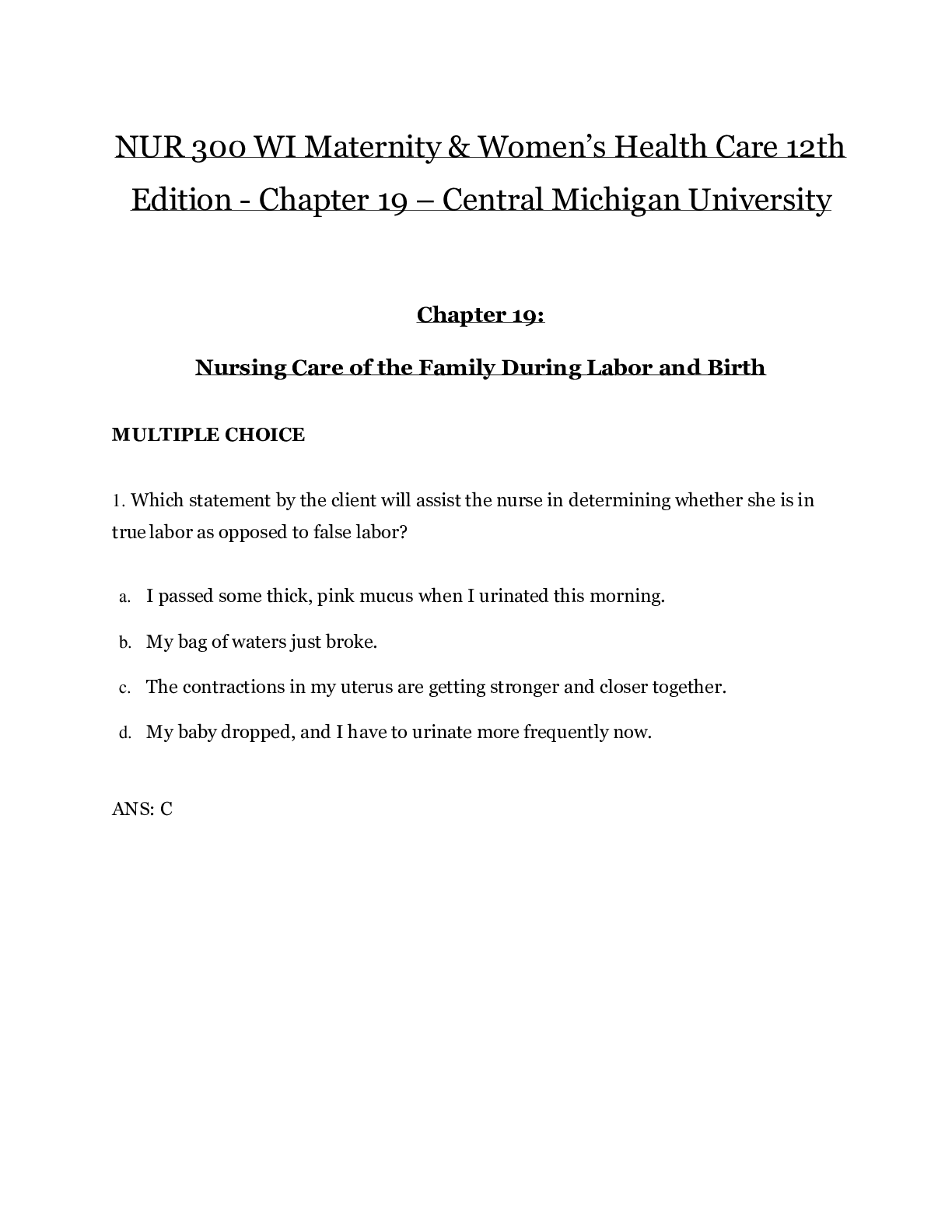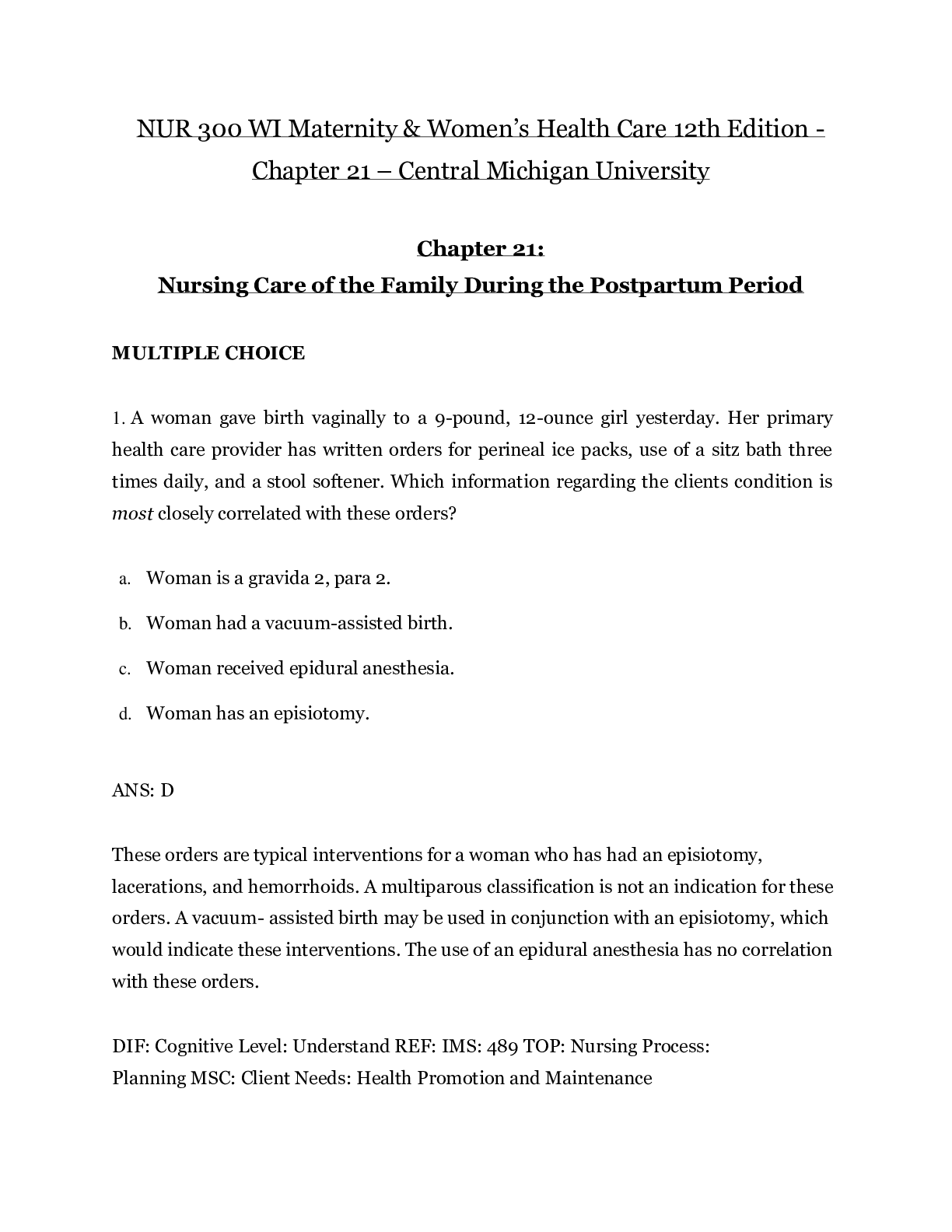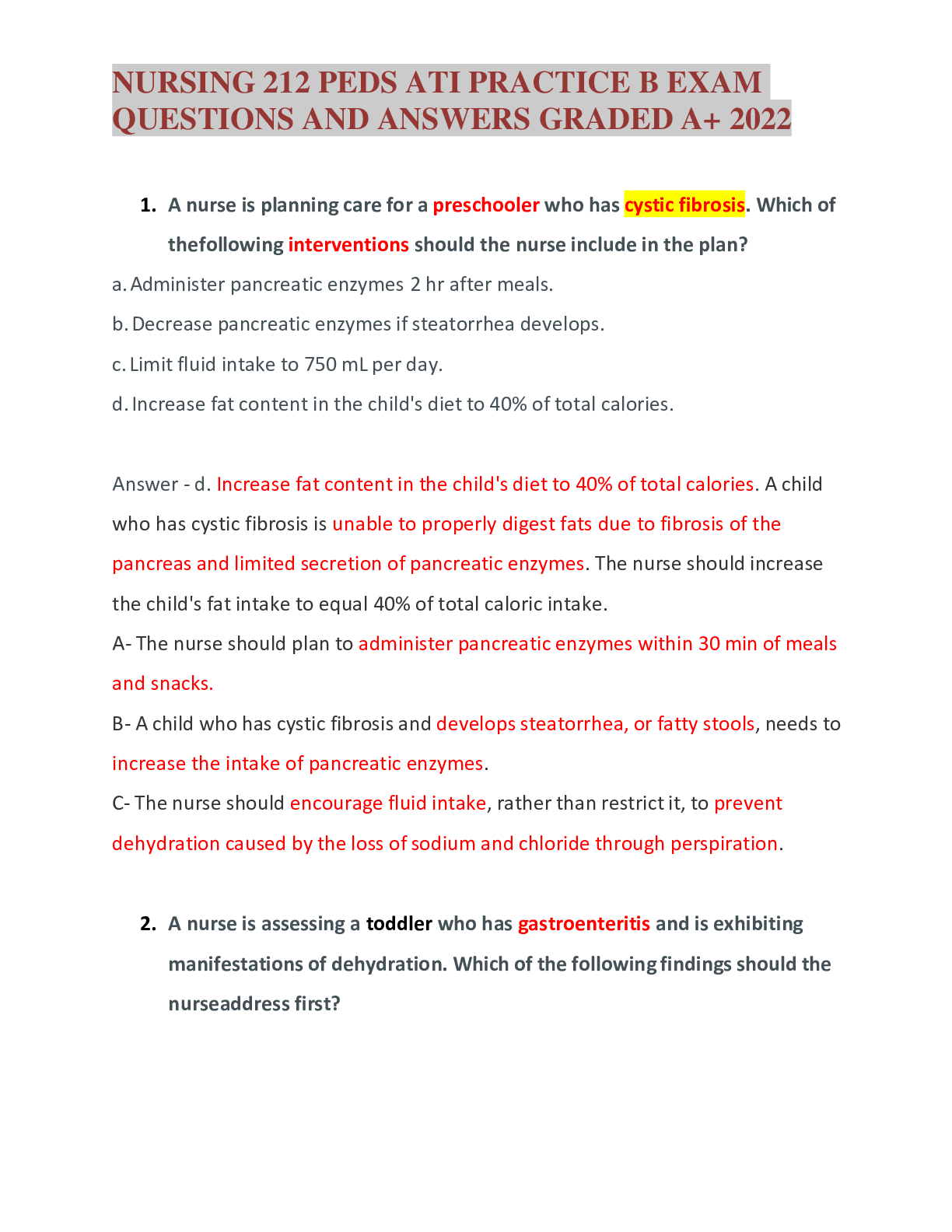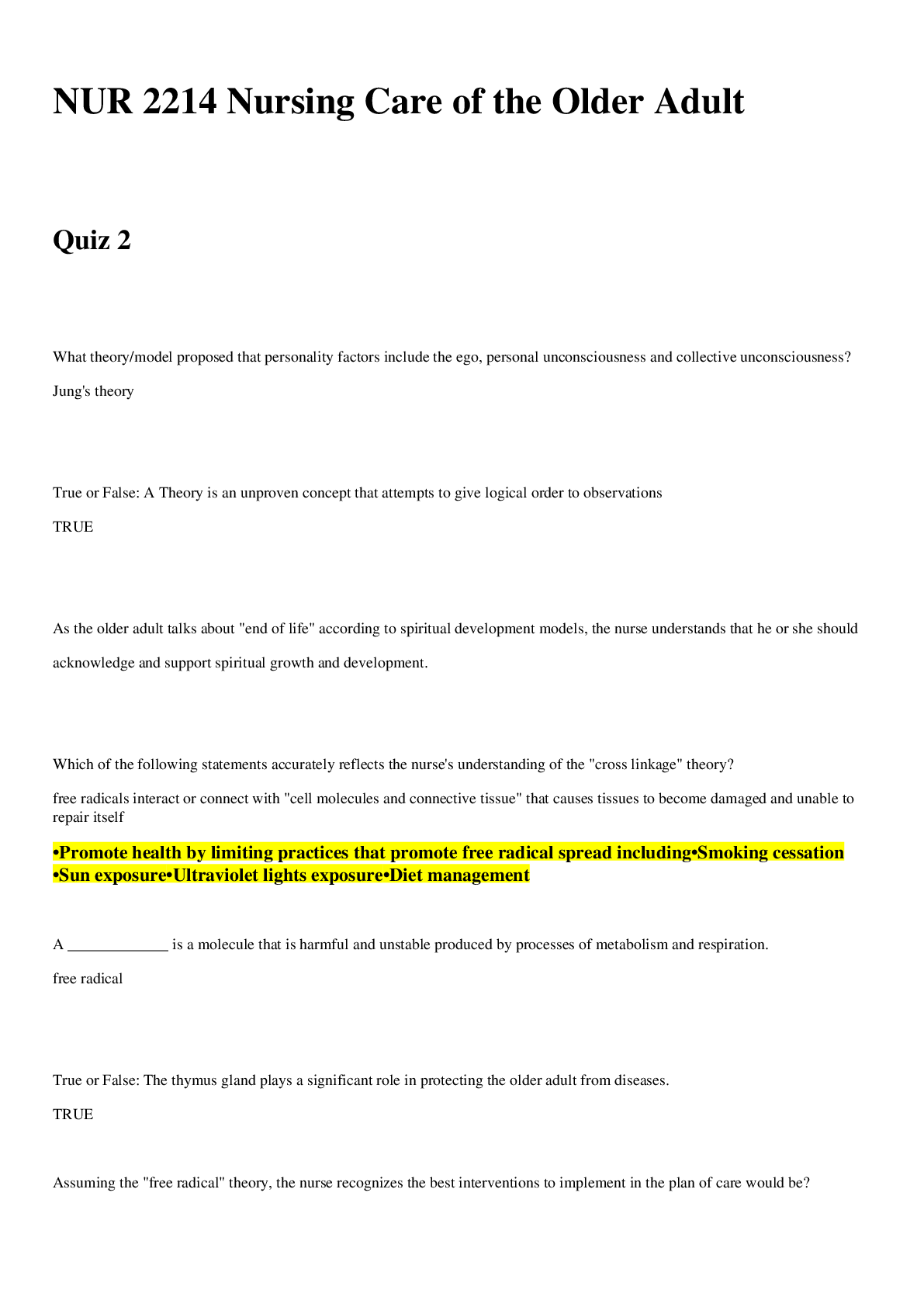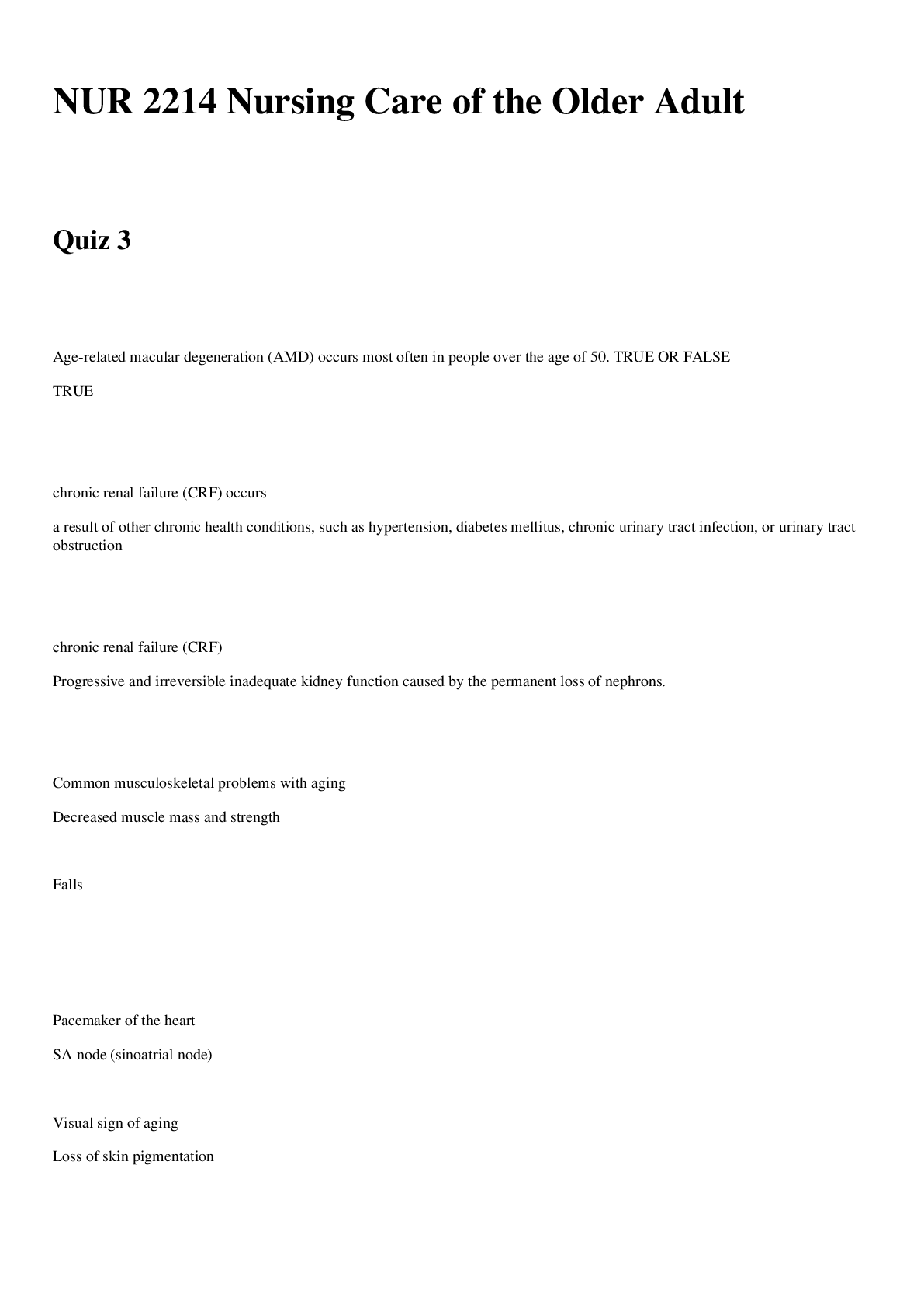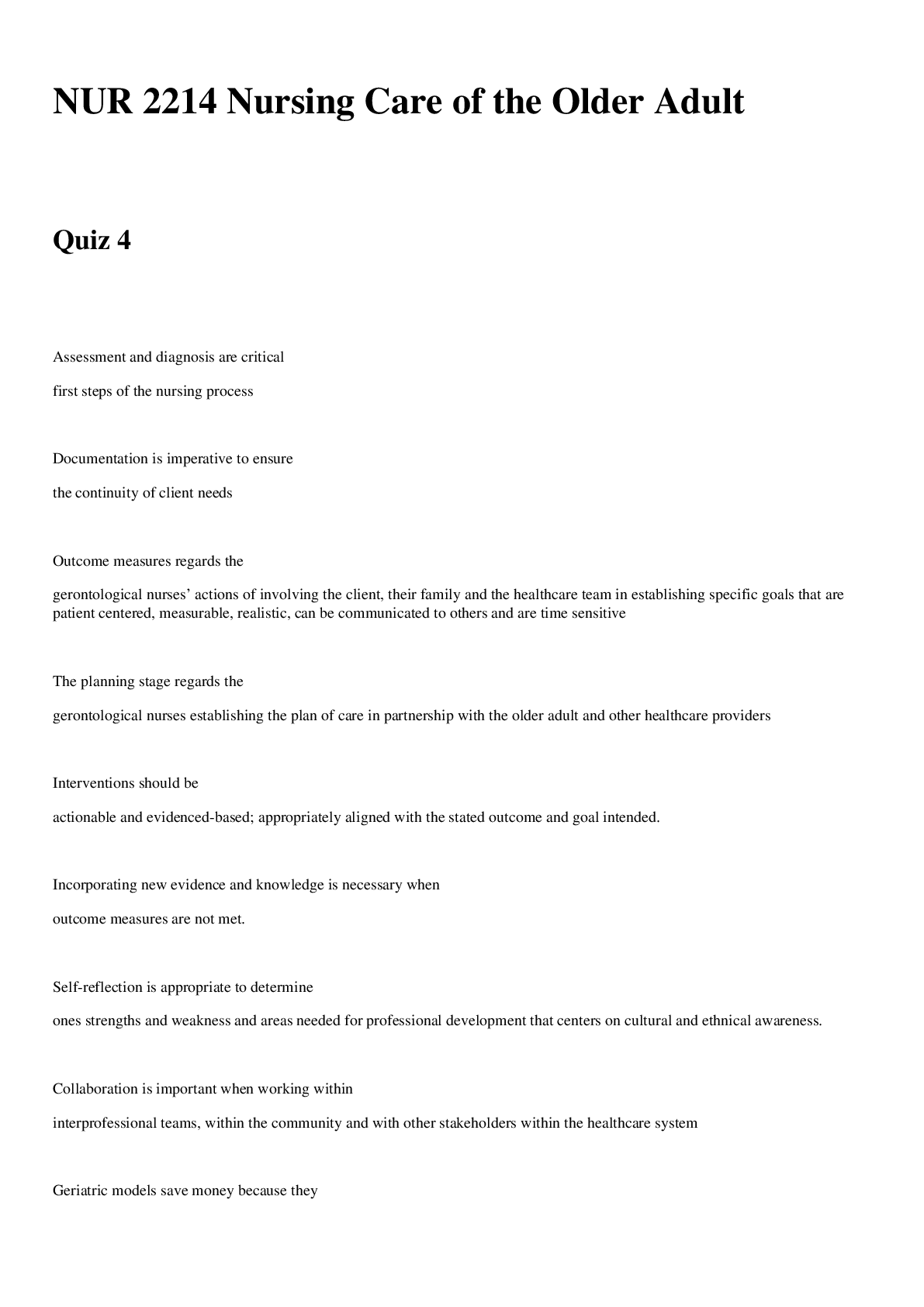Health Care > EXAM > RN VATI NURSING CARE OF CHILDREN ASSESSMENT REMEDIATION.docx (All)
RN VATI NURSING CARE OF CHILDREN ASSESSMENT REMEDIATION.docx
Document Content and Description Below
RN VATI NURSING CARE OF CHILDREN ASSESSMENT REMEDIATION.docx ❖ Management of Care – (1) ➢ Collaboration with Interdisciplinary Team – (1) ❖ Safety and Infection Control – (3) ➢ A... ccident/Error/Injury Prevention – (1) ➢ Home Safety – (1) ➢ Standard Precautions/Transmission-Based Precautions/Surgical Asepsis – (1) • ❖ Health Promotion and Maintenance – (2) ➢ Developmental Stages and Transitions – (2) ❖ Psychosocial Integrity – (1) ➢ Grief and Loss – (1) • . ❖ Basic Care and Comfort – (2) ➢ Nutrition and Oral Hydration – (2) ❖ Pharmacological and Parenteral Therapies – (5) ➢ Dosage Calculation – (1) ➢ Expected Actions/Outcomes – (1) ➢ Medication Administration – (2) ➢ Pharmacological Pain Management – (1) ❖ Reduction of Risk Potential – (6) ➢ Changes/Abnormalities in Vital Signs – (1) ➢ Potential for Complications of Diagnostic Tests/Treatments/Procedures – (2) ➢ Therapeutic Procedures – (3) ▪ Neurologic Diagnostic Procedures: Teaching a Parent About Magnetic Resonance Imaging (Active Learning Template – Diagnostic Procedure, RM AMS RN 10.0 Chp 3) • MRI scans are used to detect abnormalities, monitor response to treatment, and guide needles used for biopsies. MRIs are capable of discriminating soft tissue from tumor or bone. This makes the MRI scan effective in determining tumor size and blood vessel location ▪ Renal Disorders: Teaching Parents About Percutaneous Renal Biopsy (Active Learning Template – Diagnostic Procedure, RM NCC RN 10.0 Chp 26) • Kidney biopsy is indicated only if nephrotic syndrome is unresponsive to steroid therapy. Biopsy will show damage to the epithelial cells lining the basement membrane of the kidney. ❖ Physiological Adaptation – (8) ➢ Alterations in Body Systems – (2) ▪ Acute Neurological Disorders: Priority Action for a Child Who Has Bacterial Meningitis (Active Learning Template – System Disorder, RM NCC RN 10.0 Chp 12) • The presence of petechiae or a purpuric-type rash requires immediate medical attention. Isolate the client as soon as meningitis is suspect, and maintain droplet precautions per facility protocol. Droplet precautions require a private room or a room with clients who have the same infectious disease, ensuring that each client has his or her own designated equipment. Providers and visitors should wear a mask. Maintain respiratory isolation for a minimum of 24 hr after initiation of antibiotic therapy. ▪ Chronic Neuromusculoskeletal Disorders: Providing Teaching About Juvenile Idiopathic Arthritis (Active Learning Template – System Disorder, RM NCC RN 10.0 Chp 29) • It is a chronic autoimmune inflammatory disease affecting joints and other tissues. The chronic inflammation of the synovium of the joints leads to wearing down and damage to the articular cartilage. JIA is rarely life-threatening, and it can subside over time, but it can result in residual joint deformities and altered joint function. There are multiple classifications of JIA with or without a rheumatoid factor. • Expected findings – joint swelling, stiffness, redness, and warmth that tend to be worse in the morning or after inactivity. Mobility limitations. Fever. Rash. Limp in the morning. Delayed growth. ➢ Fluid and Electrolyte Imbalances – (1) ▪ Acute Infectious Gastrointestinal Disorders: Identifying Manifestations of Moderate Dehydration (Active Learning Template – System Disorder, RM NCC RN 10.0 Chp 22) • Weight loss – 6-9% in infants; 6-8% in children • Manifestations – capillary refill between 2-4 seconds. Possible thirst and irritability. Pulse slightly increased with normal to orthostatic blood pressure. Dry mucous membranes and decreased tears and skin turgor. Slight tachypnea. Normal to sunken anterior fontanel on infants. ➢ Illness Management – (2) ▪ Diabetes Mellitus: Providing Dietary Teaching for a School-Age Child (Active Learning Template – System Disorder, RM NCC RN 10.0 Chp 33) • Provide nutritional guidelines – read labels for nutritional value. Meal planning is based on the requirements of growth and development of the child. Plan meals to achieve appropriate timing of food intake, activity, onset, and peak of insulin. Calories and food composition should be similar each day. Eat at regular intervals and do not skip meals. Count grams of carbohydrates consumed. Recognize that 15 g of carbohydrates are equal to 1 carbohydrate exchange. Avoid high-fat and high-sugar/high-carbohydrate food items. Use artificial sweeteners in moderation. ▪ HIV/AIDS: Providing Teaching About Infection Prevention (Active Learning Template – System Disorder, RM NCC RN 10.0 Chp 38) • Prevent infection using standard precautions – encourage deep breathing and coughing. Maintain good hand hygiene. Teach the child and parents to avoid individuals who have colds/infections/viruses. Encourage immunizations, such as pneumococcal vaccine and yearly seasonal influenza vaccine. Monitor for indications of opportunistic infections. ➢ Medical Emergencies – (1) ▪ Hematologic Disorders: Interventions for a Child Who Has Hemophilia (Active Learning Template – System Disorder, RM NCC RN 10.0 Chp 21) • Management of bleeding in the hospital – administer injections via the subcutaneous route instead of the intramuscular route whenever possible. Avoid unnecessary skin punctures and use surgical aseptic technique. Venipunctures are preferred over finger or heel sticks for blood sampling. Monitor urine, stool, and nasogastric fluid for occult blood. Do not administer aspirin or any products that contain aspirin. Acetaminophen is an acceptable substitute for aspirin. Control localized bleeding – administer factor replacement. Observe for adverse effects, which include headache, flushing, low sodium, and alterations in heart rate and blood pressure. Encourage the child to rest and immobilize the affected joints. Elevate and apply ice to the affected joints. ➢ Pathophysiology – (2) ▪ Brain Tumors: Identifying Manifestations of a Brain Tumor (Active Learning Template – System Disorder, RM AMS RN 10.0 Chp 9) • Physical assessment findings – dysarthria, dysphagia, positive Romberg sign, positive Babinski sign, vertigo, hemiparesis, cranial nerve dysfunction (inability to discriminate sounds, loss of gag reflex, loss of blink response), papilledema • Manifestations specific to supratentorial brain tumors – severe headache (worse upon awakening but improving over time). Visual changes (blurring, visual field deficit). Seizures. Loss of voluntary movement or the inability to control movement. Change in cognitive function (memory loss, language impairment). Change in personality, inability to control emotions. Nausea with or without vomiting. Paralysis. • Manifestations specific to infratentorial brain tumors – hearing loss or ringing in the ear. Visual changes. Facial drooping. Difficulty swallowing. Nystagmus, crossed eyes, or decreased vision. Autonomic nervous system (ANS) dysfunction. Ataxia or clumsy movements. Hemiparesis. Cranial nerve dysfunction (inability to discriminate sounds, loss of gag reflex, loss of blink response) ▪ Cardiovascular Disorders: Identifying Manifestations of Tetralogy of Fallot (Active Learning Template – System Disorder, RM NCC RN 10.0 Chp 20) • Tetralogy of Fallot – four defects that result in mixed blood flow: pulmonary stenosis, ventricular septal defect, overriding aorta, right ventricular hypertrophy. ◆ Cyanosis at birth: progressive cyanosis over the first year of life. Systolic murmur. Episodes of acute cyanosis and hypoxia (blue or “Tet” spells) [Show More]
Last updated: 1 year ago
Preview 1 out of 15 pages
Instant download

Buy this document to get the full access instantly
Instant Download Access after purchase
Add to cartInstant download
Reviews( 0 )
Document information
Connected school, study & course
About the document
Uploaded On
Aug 06, 2021
Number of pages
15
Written in
Additional information
This document has been written for:
Uploaded
Aug 06, 2021
Downloads
0
Views
100



